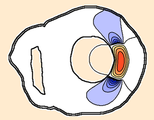Med. Biol. Eng. Comput. 45(12):1187-1199, 2007.
other versions
abstract
Myocardial ischemia is associated with large mortality and morbidity. Understanding of the relations between coronary artery occlusion, geometry of the ischemic region, physiology of ischemia, and the resulting changes in ECG leads and catheter signals is important to support diagnosis and treatment. Computer models play an important role in understanding ischemia, by linking experimental to clinical results. In this paper we argue that the observed transport of extracellular potassium should be represented in such models. We used a diffusion equation to describe the transport mechanism. This model reproduced the measured spatial distribution of potassium, and its temporal development. We discuss the role of potassium transport next to other aspects of ischemia: the mechanism of changes in action potential and ECG, cellular coupling, anisotropic bidomain tissue conductivity, and the geometry of the ischemic zone.
lay abstract
The ability to determine what a theory predicts is essential to science. In complex systems, such as the heart, prediction can require extensive use of mathematics. We then use a "mathematical model" of the heart. This paper deals with a rather technical detail of mathematical heart models: the transport of potassium ions in the tissue. Normal muscle contains a small concentration of potassium, which it requires to do its work. When there is not enough oxygen supply to the muscle ("ischemia"), as happens during a heart attack, much more potassium than usual leaks out of the cells and ends up in the extracellular space. However, rather than being stuck in the ischemic zone, potassium ions move slowly towards the non-affected regions of the heart. This came as a bit of a surprise when it was initially discovered, because there is presumably no blood flow in the affected area. Thus, it is not known how the potassium ions are transported. However, we have found a mathematical description of this phenomenon. This can help in creating more realistic mathematical models of ischemia, and gives us a clue about the unknown mechanism.
funding
Computational resources for this work were provided by the
Réseau québécois de calcul de haute performance
(RQCHP).
